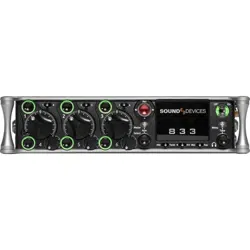Loading ...
Loading ...
Loading ...

Slate microphone
A microphone, built-in or external microphone, on an audio mixer used to notate takes or communicate with sound team members
by the mixer’s user speaking into the microphone. Slate microphones are often routable to buses or tracks.
Smart Battery
A lithium-ion rechargeable battery with integrated telemetry indicating battery condition, run time and other useful data.
Stereo linking (inputs)
When active for stereo sources such as stereo microphones, linked inputs are hard panned to the left and right bus. Controls
including gain (trim), fader, high pass filter, delay, limiter, mute, and routing are controlled together.
Solo
A control on a mixer to route a channel to headphones while muting all others. Solo and PFL are related controls and in many
consoles are the same. Solo circuits can be exclusive—only one channel is sent to headphones at a time—or non-exclusive—any
number of channels can be sent to the solo circuit and appear in headphones.
SuperSlot™
SuperSlot™ is an electro-mechanical connection protocol, developed by Sound Devices, to simplify the interconnection of wireless
audio transmitters and receivers with audio mixers and cameras. SuperSlot provides, power, audio, and control signals over a single
multi-pin connection. SuperSlot-compatible products will be offered by multiple manufacturers, including wireless system
manufacturers, camera manufacturers, and audio mixer manufacturers.
TA-type connector (TA3, TA4,TA5)
Miniature XLR-type, locking connectors. TA3 connectors are used by Sound Devices for various inputs, outputs, and as balanced
and unbalanced connections. TA4 connectors are used by Sound Devices for DC power connections to the 833 mixer-recorder. TA4
is also used for audio connections from lavalier microphones to some wireless transmitters. TA5 connectors are used for the 833
headset input. TA6 connectors are presently not used by Sound Devices though they are used for audio connections by other
manufacturers.
Take
A recorded take is an individual recorded file (or files when recording monophonic WAV files) generated by a recorder. Take
numbers are auto-incrementing. Take numbers are added to the end of the file name.
Take list
Separate from a file list, a take list consolidates related files such as a group of monophonic WAV files generated by a single take
and presents them as a single take.
Test tone
See tone oscillator.
Timecode
A numerical clock value expressed in hours:minutes:seconds:frames, i.e. 04:59:39:05, used to synchronize cameras, video decks,
and audio recorders. Timecode requires clocks on devices to be synchronized, either through a wired or wireless connection
between devices, or through a process called “jam sync” where each device, which requires a high-precision clock, runs
independently after their clocks are synchronized.
Timecode mode
Sound Devices recorders offer multiple timecode modes. Different modes correspond to different timecode workflows. Common
modes available in Sound Devices recorders include:
record run - timecode advances only when recording is engaged
free run - timecode run continuously, typically with the start of production being at 0 hour
24 hour - similar to free run except the start time corresponds to time-of-day
ext TC - the recorder applies the value of an external timecode source.
Tone oscillator
A sound generator producing a sine wave tone at a given frequency at a given output level. With its known output level tone
oscillators are helpful to set gain structure between audio equipment.
Track
833 User Guide 118
Loading ...
Loading ...
Loading ...
